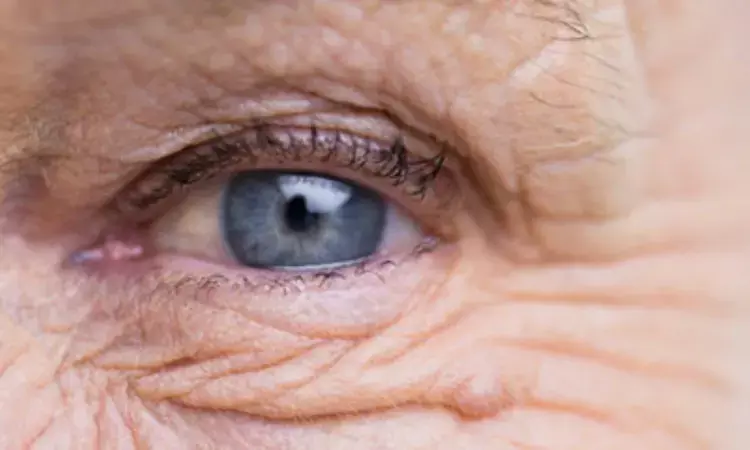- Home
- Medical news & Guidelines
- Anesthesiology
- Cardiology and CTVS
- Critical Care
- Dentistry
- Dermatology
- Diabetes and Endocrinology
- ENT
- Gastroenterology
- Medicine
- Nephrology
- Neurology
- Obstretics-Gynaecology
- Oncology
- Ophthalmology
- Orthopaedics
- Pediatrics-Neonatology
- Psychiatry
- Pulmonology
- Radiology
- Surgery
- Urology
- Laboratory Medicine
- Diet
- Nursing
- Paramedical
- Physiotherapy
- Health news
- Fact Check
- Bone Health Fact Check
- Brain Health Fact Check
- Cancer Related Fact Check
- Child Care Fact Check
- Dental and oral health fact check
- Diabetes and metabolic health fact check
- Diet and Nutrition Fact Check
- Eye and ENT Care Fact Check
- Fitness fact check
- Gut health fact check
- Heart health fact check
- Kidney health fact check
- Medical education fact check
- Men's health fact check
- Respiratory fact check
- Skin and hair care fact check
- Vaccine and Immunization fact check
- Women's health fact check
- AYUSH
- State News
- Andaman and Nicobar Islands
- Andhra Pradesh
- Arunachal Pradesh
- Assam
- Bihar
- Chandigarh
- Chattisgarh
- Dadra and Nagar Haveli
- Daman and Diu
- Delhi
- Goa
- Gujarat
- Haryana
- Himachal Pradesh
- Jammu & Kashmir
- Jharkhand
- Karnataka
- Kerala
- Ladakh
- Lakshadweep
- Madhya Pradesh
- Maharashtra
- Manipur
- Meghalaya
- Mizoram
- Nagaland
- Odisha
- Puducherry
- Punjab
- Rajasthan
- Sikkim
- Tamil Nadu
- Telangana
- Tripura
- Uttar Pradesh
- Uttrakhand
- West Bengal
- Medical Education
- Industry
Faricimab reduces fluid in Neovascular Age-Related Macular Degeneration eyes, unravels study

Age-related macular degeneration (ARMD) is the leading cause of severe vision loss in the developed world for people over 55 years old. Anti-vascular endothelial growth factor (anti-VEGF) therapies for macular neovascularization have been pivotal in decreasing the number of individuals visually impaired by neovascular age-related macular degeneration (nARMD). Faricimab is a novel antibody for the treatment of nARMD that aims to neutralize not only VEGF-A but also Angiopoietin-2 (Ang-2), thus targeting two distinct pathways involved in nARMD pathogenesis. Faricimab was initially shown to be non-inferior to aflibercept in terms of change in best corrected visual acuity (BCVA) at one year for treatment-naïve individuals. Many patients were also able to achieve long dosing intervals of 12 or 16 weeks on faricimab.
This study aimed to collect functional and optical coherence tomography (OCT)-based morphological observations after faricimab treatment in a particular subset of eyes that showed persistent subretinal and/or intraretinal fluid despite previous treatment with at least two other anti-VEGF agents. Authors hypothesized that eyes refractory to treatment with multiple prior anti-VEGF agents may still be able to respond anatomically and/or functionally to faricimab injections based on the novel mechanistic nature of the antibody.
Retrospective chart review was conducted on eyes with nARMD with persistent subretinal and/or intraretinal fluid despite previously receiving ≥15 injections with ≥2 different anti-VEGF agents. Best corrected visual acuity (BCVA) and optical coherence tomography (OCT) parameters were collected at baseline, initial post-injection visit, and most recent visit with OCT following last faricimab.
Nineteen eyes were included. Average logMAR BCVA was 0.47 ± 0.60 at baseline, 0.42 ± 0.47 at initial follow-up (p=0.38), and 0.51 ± 0.63 at final visit (p = 0.50). Average central subfield thickness (CST) was 310 ± 92 μm at baseline, 279 ± 88 μm at initial follow-up (p = 0.001), and 274 ± 100 μm at last visit (p < 0.001). 9 eyes (47%) achieved resolution of fluid at both initial and final follow-up visits.
While many eyes with nARMD respond favorably to initial anti-VEGF therapies, there is a significant subset of eyes that show persistent signs of disease activity with non-resolving macular edema despite several routine anti-VEGF treatments and thus may have worse visual outcomes. For this subset of patients, switching anti-VEGF agents is often a consideration. Authors hypothesized that faricimab may benefit eyes with previous incomplete response or non-response to two or more traditional anti-VEGF agents due to the novel mechanistic nature of the antibody. The results of the present study suggest that faricimab may result in anatomic improvement in this subset of patients without evidence of an associated functional benefit in terms of improvement in BCVA. CST, which started at an average of 310 ± 92 μm, decreased to 279 ± 88 μm by the initial follow-up visit, with minimal subsequent decrease to a final average of 274 ± 100 μm at last follow-up. Additionally, 9 eyes (47%) showed resolution of fluid at both initial follow-up and final follow-up visits.
In a subset of eyes with nARMD that showed persistent intraretinal and/or subretinal fluid refractory to treatment with traditional anti-VEGF agents, faricimab resulted in anatomic improvement in terms of mildly decreased CST and resolution of fluid in several eyes. However, there was no significant associated change in BCVA.
Source: Qaseem et al; Clinical Ophthalmology 2024:18 3097–3102
Dr Ishan Kataria has done his MBBS from Medical College Bijapur and MS in Ophthalmology from Dr Vasant Rao Pawar Medical College, Nasik. Post completing MD, he pursuid Anterior Segment Fellowship from Sankara Eye Hospital and worked as a competent phaco and anterior segment consultant surgeon in a trust hospital in Bathinda for 2 years.He is currently pursuing Fellowship in Vitreo-Retina at Dr Sohan Singh Eye hospital Amritsar and is actively involved in various research activities under the guidance of the faculty.
Dr Kamal Kant Kohli-MBBS, DTCD- a chest specialist with more than 30 years of practice and a flair for writing clinical articles, Dr Kamal Kant Kohli joined Medical Dialogues as a Chief Editor of Medical News. Besides writing articles, as an editor, he proofreads and verifies all the medical content published on Medical Dialogues including those coming from journals, studies,medical conferences,guidelines etc. Email: drkohli@medicaldialogues.in. Contact no. 011-43720751


